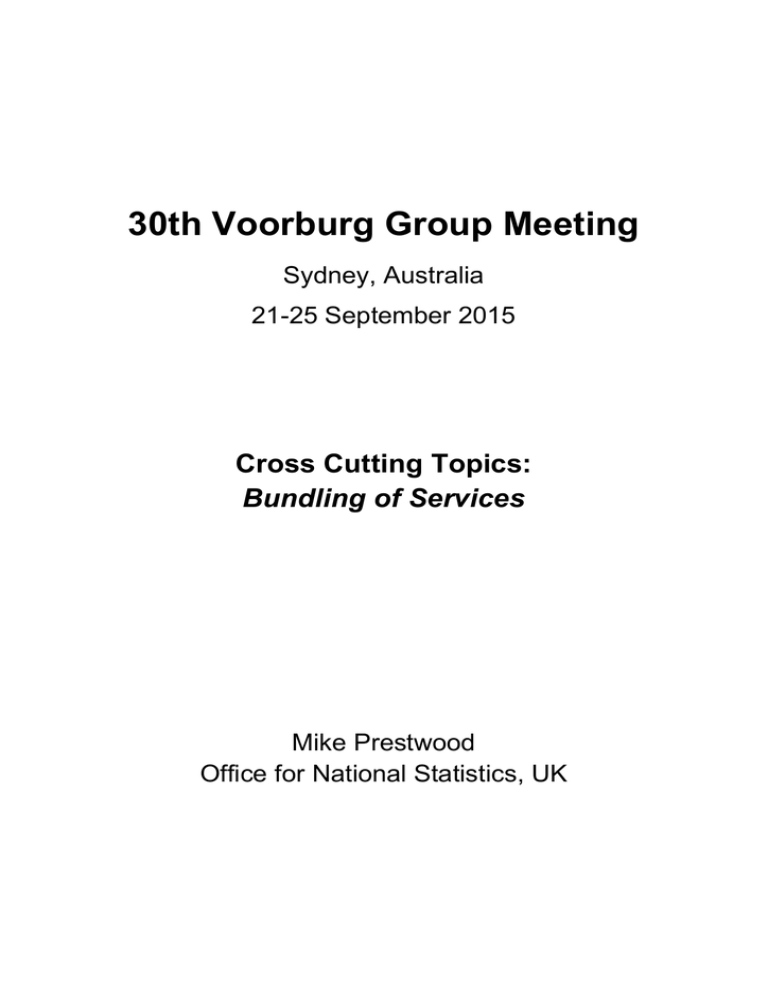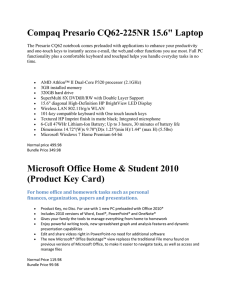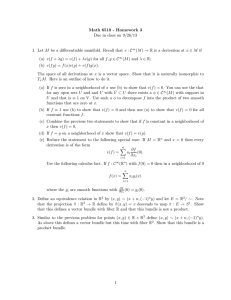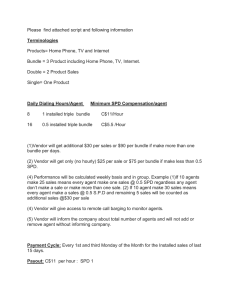30th Voorburg Group Meeting Cross Cutting Topics: Bundling of Services
advertisement

30th Voorburg Group Meeting Sydney, Australia 21-25 September 2015 Cross Cutting Topics: Bundling of Services Mike Prestwood Office for National Statistics, UK 1. Introduction This paper sets out the subject of bundling of services; initially by considering the concept, issues associated with it and how these could be overcome. It then explores bundling from the UK perspective, considering a range of questions, in line with those posed by the ‘Bundling of Services’ session leader. As the UK currently doesn’t address bundling that much in its statistics, this paper reflects more on the options and possible answers for the issues, rather than categorically determining the way that it should best be addressed. Its aim is therefore to elicit broad debate around the issue, so as to be able to consider implementing consistent approaches across the National Statistical Institutes (NSI). 2. What is bundling? 2.1 The definition in the Eurostat/OECD SPPI manual says ‘where one product is sold in combination with another as a requirement for the sale.’ An easy example of this is telecommunications – where most providers will now offer phone, SMS, data, TV and internet within the bundled package. That is a straight forward example, but within a bundle, there can be many combinations of: the number and percentage of products, for example: ➔ 100% - where the provider offers a home entertainment package including all the components; of TV, internet broadband, phone line and charges, or ➔ 1-99% - where the consumer may just have a reduced sized bundle, such as the TV and phone; with their internet provided by a separate provider, and the mix of classification industries associated with the products in the bundle, for example: ➔ the consumer has a phone bundle that also includes repair/maintenance. The latter service would probably be contracted out to a separate service provider, as it is a different industry – however getting prices for that separate service can be difficult. 2.2 Within the above, there are also some further sub-aspects that need consideration, such as: the difficulty in distinguishing the individual product prices within the bundle, and whether they are all at a reduced rate - or whether a nonmain product is offered at a discounted price, only if it is purchased with the main product at full price, and whether the bundled service consists of products that occur simultaneously, such as in TV packages, or whether it is an end-to-end process, such as a freight movement/cargo handling/storage business. More detailed examples about these are included later in the paper. 2.3 As a concept, bundling has really grown in prominence in the last decade, especially as it maps well onto the type of industries that have seen large growth, but more importantly, where there is extensive competition in pricing. 3. Why is bundling an issue for price indices? Pricing index structures are based on defining homogeneous service products. A bundled price, consisting of various products, does not provide the disaggregated price components that are required. This provides a key problem, as the homogeneity is lost. Overcoming this is difficult, and creates many issues in determining appropriate prices. Possible solutions could be sought if: 1. the NSIs can identify the individual components within the bundles, and 2. the service providers can provide separate component prices The second point is particularly important, as identifying the bundled components is the easier of the two aspects, but this provides little benefit unless the service providers can actually produce prices at those required levels. However, even if component prices can be provided, further issues can lie within this, as to how these components are actually priced by the provider, namely: • are the components proportionately equal in price? • are some components at full price with others discounted? • does the level of discounting depend on the volume of each component purchased? • do bundle prices change if the component prices change, and vice versa; so if the components change price, is there an impact on the bundle price? There are thus many issues with bundling, which can theoretically be overcome. However, it is a fairly complex range of issues that need addressing, and there are several ways to handle these. This can be dependent on the type of industrial sectors involved, the approach of the NSI and the data available – but a broad concensus on the issue would give much improvement on statistical quality and comparability. 4. Options for dealing with bundling of services There are a few approaches to address bundling of services in government statistics, namely: o ‘Ignoring’ them o Include bundling of services as a separate product in the aggregation structure o Assume same price movement for each of the products included in the bundle o Calculate price for each bundle component Below looks at each of these in more detail, taking the following example for a wired telecommunications index, to illustrate the difference outcomes of each approach: Wired telecommunications Call charges [A] Line rental [B] BUNDLE (call charges & line rental) [C] Service product Weight Price (July) Price (August) Price Relative [A] Call charges 25 0.05 0.06 1.2 [B] Line rental (£) 25 17 17.50 1.03 [C] BUNDLE – calls 50 25 26 1.04 (£/min) & line rental (£) 4.1 ‘Ignore’ bundling services This approach ‘ignores’ the bundled price, and calculates the price index solely on the basis of the separate service products [A & B]. So, for the above data: Index = Call charges (1.2 * 25) + Line rental (1.03 * 25) = 1.12 --------------------------------------------------------------50 This is what mainly happens in the UK for the telecommunications industry. This is obviously not ideal, and conceptually bundling service discounts should be included, in trying to measure the actual transaction. This exclusion will lead to existing indices not being representative and having bias, whereby we are potentially overstating inflation. Against this though is that if bundling occurs frequently, and comprises say 95% of the turnover of the industry, then the remaining coverage of the actual component products can be quite low, thus leading to quality issues at the disaggregate product level. 4.2 Include as a separate ‘product’ in aggregation structure This approach creates a new separate product [C], which represents the contents of the bundle - thus the index will consist of this, in addition to the separate component products, giving: Index = [A] (1.2 * 25) + [B] (1.03 * 25) + [C] (1.04 * 50) = 1.08 ------------------------------------------------------------100 This could potentially solve the problem at the aggregate level, but a separate index for ‘bundles’ might not be so meaningful, and cause other issues. It could cause problems at the lower aggregate levels, as these will be biased (bundles under estimate, whereas bundle component indices may overstate inflation for those aspects). There is also an issue as to how often the specification/components of bundles change – in a competitive market, this could be fairly frequent, to ensure the service provider stays ahead of its competitors and/or provides innovative bundle combinations. Overall, this could lead to difficulties in properly measuring price changes, and the need for frequent quality adjustments. 4.3 Assume same price movement for each of the products in the bundle This would assume a starting price for each component of the bundle and apply the movement of the whole bundle to each of these, as shown: Index = [Call + Call (from bundle)] + [Line + Line (from bundle)] -----------------------------------------------------------------------100 Index = [(1.2 * 25) + (1.04 * 25)] + [(1.03 * 25) + (1.04 * 25)] --------------------------------------------------------------------100 = 1.08 This would give more meaningful sub-indices for product details, and seems a good approach. However, it could be difficult to apply, as there would need to be quality adjustments to the bundle and the price index. 4.4 Calculate price for each bundle component This approach requires the business to estimate the price and weight of each component within the bundle. Businesses would need to provide prices when first recruited and be able to continually provide this. Experience has indicated that both these aspects are not always possible. In addition, changes to the composition of the bundle could make this difficult to maintain. This would be a key factor, as bundles would be expected to frequently change, with businesses operating in a competitive market. In summary, ‘ignoring’ the bundle would be operationally easiest, but this would lead to over-estimating the price index. Therefore, incorporating the bundle is the preferred option, but there are a few ways to do this, and a large dependency on businesses being able to provide the appropriate individual component prices. This latter point thus becomes the key driver in the way that bundled services are incorporated into economic statistics, and will tilt the balance in the approach adopted – albeit recognizing that 4.3 and 4.4 are more difficult, and probably pricier, to implement. 5. UK response to session leader questions The above sections have given a flavour of some of the issues with bundling, but this section deals specifically with the range of questions posed by the ‘Bundling of Services’ session leader, so as to assist in a constructive discussion. There are six questions, although at times, the answer refers back to information provided earlier in the paper, to minimise duplication: 5a. In what industries and with what products do you observe bundling as a prevalent activity? The main industries affected in the UK are: Telecommunications: Most providers will now offer phone (calls and line rental), SMS, data, TV and internet services. In some cases, these also extend to repair/maintenance and insurance packages too - although this provides the added complication of a mixed industry classification within the bundles, as mentioned earlier. A key issue here is the product classification system - whilst a good quality product classification can cope with this, there is a less detailed classification for services. Where the classification does not meet the NSI requirements, there can sometimes be a need to create some ’additional’ localised classifications to meet the statistical needs. Also, the range of service products in the bundle is probably managed within different departments of a business, making it quite difficult to acquire accurate price statistics for the different products of the bundle. This means that any attempt to collect good price data for the range of telecoms products can be met with resistance, as the person receiving the request can only provide data for one specific product (or at most a limited number of them). Another issue is the ability of companies to actually 'de-bundle' packages for pricing purposes. In the UK, we have tried to collect product level turnover data from the telecoms sector, but they were unable to provide the level of data required, as they did not distinguish between certain products (for example, they couldn't separate mobile data and mobile SMS charges). Whilst this example is related to the collection of turnover, the same issue would be applicable to price collections. Engineering and freight industries (due to the 'end-to-end' service): Both of these provide examples where there is a tendency for companies to now provide a full logistics solution. This means that the customer is now getting an end-to-end service - so this will include (for engineering) plans/groundwork, engineering service work and testing, and (for freight) the freight movement, cargo handling and storage. This also introduces another difficulty, in terms of outsourcing, as the storage company will outsource the freight movement to a freight company but charge the customer for the full end-to-end service. Again this provides a problem for pricing the product as the company cannot separately identify the cost of each component. Computer services - network services: This provides the support services for a range of computer services, whether it be for PCs, printers or overall networks. The nature of this service, and the components within the bundle, cannot easily be split apart, and the pricing for these bundles is normally provided as an overall price, rather than the individual components. Hotel accommodation There is a basic cost for overnight accommodation, but staying at a hotel comes with many extra facilities, such as leisure facilities, breakfast and sometimes bar/room service that can be interpreted as being within a bundle. Similar to computer services, it is difficult to split off the components, and this is normally priced as a single bundle price. 5b. What challenges with existing product classifications does your country encounter because of bundling? The main, and fundamental, challenge is the inability of businesses to split off the separate products, as they are bundled up. Earlier in the paper, there was mention of other options to measure bundled prices without having the component products split off – however, in the UK we have not yet pursued this much. For industries such as telecommunications, there wasn't much of a problem when the index was set up. Whereas, for others such as engineering, we have decided to accept the issue, and have not yet fully reviewed the industry to make any necessary changes. 5c. Are there areas where you think product or industry classifications need to change to take into account areas where there is a high degree of product bundling? What changes would you suggest? The most obvious suggestion here is to create a separate ‘bundle product’, and the price comparisons can be made for that product. This could be quite easy if the bundle is a combination of products that are predominantly provided as a bundled product, rather than the separate components. It would also be further enhanced if the composition of the bundle remained fairly constant, and would be even better if there were not many variant product combinations. Some issues with this though are: • how the individual products within the bundle are covered as separate items [products A and B from the earlier diagram]. The answer to this is to have the ‘bundle product’ as an additional product [product C] to products A and B. There does remain an issue though as to whether the price movement in the bundle [C] should, in some way, impact on the prices of A and B, and vice versa. • if the specification of the bundle changes frequently, will it be too difficult to follow price movements • if a service user doesn't want the 2nd or 3rd part of the bundle, how is that handled – does it become another ‘bundle product’, say product D. In the case of telecommunications, we could end up with about 10 ‘bundle product’ variants. 5d. How are bundles treated in services output statistics in your country? Are there practices that you think could help other countries resolve similar issues of bundling? Do you have other ideas of how to resolve the issues of bundling that you have not tried? The treatment of bundles in services output statistics is not much advanced from that undertaken for prices. It experiences the same problems, and is dependent on how comprehensive specifications are, and how often they are updated. Implicitly the UK does address the bundling of services in some areas, say hotel fees, where some additional services are included as standard (bar, gym, room service), as against more chargeable services such as laundry. But explicitly, difficulties are experienced with telecommunications, computer software, electrical goods (with insurance), IT hardware (with maintenance). An associated issue is the provision of free services, such as newspapers, apps on mobile phones. National Accounts deflation is on a product basis, to allow for more clarity in the deflation process – but increasingly services are offered from one ‘bundled’ contract, covering a range of products. Therefore, how the turnover of a business is reported for National Accounts becomes increasingly important as well as having good prices for the products. 5e. How are bundles handled in specific SPPIs? Are there practices that you think could help other countries resolve similar issues of bundling? Do you have other ideas of how to resolve the issues of bundling that you have not tried? There is not much to add here, to that already covered earlier in the paper, in Section 4. 5f. What issues does bundling cause your National Accounts’ calculation of volume of services outputs? What impact would any of your proposed classification changes or proposed methods to resolve bundling in turnover and SPPI programs have on your country’s SNA? Not much more to add here to that included in the answer incorporated into 5d. above.







